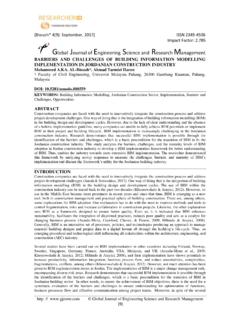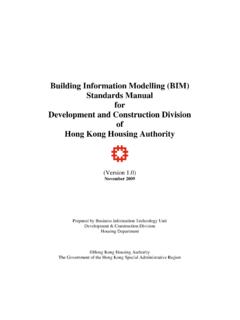Transcription of Introduction The birth of BIM - BIM Level 2
1 Introduction The birth of BIM building information modelling (BIM) sits at the heart of digital transformation across the global economic and social infrastructure sector. For the construction industry, a major part of the UK economy, it provides a critical opportunity to significantly improve performance. As a core element of the UK Government s Digital Built Britain strategy, BIM should also eventually help citizens to make better use of the transport, water, communications and energy infrastructure already in place and help to boost value from the investment made in sustaining those assets. Essentially BIM involves the use of digital tools to collaboratively manage information and data across the entire life cycle of built environment assets. It is a process, enabled by technology, that focuses on outcomes and derives value from open, sharable asset information .
2 It is a way of working, not just an application. At its core BIM uses 3D models with attached data and information to connect and share information efficiently across the supply chain and so boost the efficiency of activities around asset delivery and operation. By helping the entire supply chain to work from a single source of information , BIM reduces the risk of error, maximises the project team s ability to innovate and drives efficiency, transparency and productivity. And if the project information isn t shared or repurposed then it isn t truly a BIM process. According to the UK Government's later construction benchmarking report, the BIM programme has been a major contributor to the combined record industry savings of between 2013 and 2015. Having contributed to meeting the 2011 Government Construction Strategy (GCS) target of saving 25% on the cost of public sector capital projects, BIM is recognized as a significant tool to help the industry to continue to drive down cost and increase value for money and will contribute to the forecast efficiency savings of over the course of this Parliament, as set out by the latest 2016 2020 GCS.
3 At the industry s leading edge, there are companies which have the capability of working in a fully collaborative 3D environment, so that all of those involved in a project are working on a shared platform with reduced transaction costs and less opportunity for error; but construction has generally lagged behind other industries in the adoption of the full potential offered by digital technology. Construction Strategy 2011, Subclause The purpose of this Guide This guide is intended to help construction industry professionals, suppliers, clients and asset owners/operators understand and adopt all aspects of Level 2 BIM; a Level of BIM maturity defined as embracing file based collaboration and library management in the delivery of assets. The goal is to help construction professionals and clients to build business strategies and plans that capitalize on the benefits offered by these processes.
4 Each chapter in this guide is designed to help the UK industry understand how BIM Level 2 specifically the use of 3D models, data and collaborative working can drive greater performance from asset delivery and operations teams, and so derive greater value from across the capex (capital expenditure) and opex (operating expenditure) life cycle of assets. The guide also demonstrates how clients have complied with the UK Government s mandate for the use of BIM Level 2 on public sector projects, and explains what steps can be taken to deliver greater levels of BIM-enabled information exchange, both on new projects and programmes and in connection with the operation of existing asset portfolios. It is also expected that the guide will help the UK construction supply chain to accelerate the wider adoption of Level 2 principles and so embed the thinking and technology into the supply chain's business operations.
5 Who is this guide aimed at? The guide is aimed at construction professionals at all management levels and from across the entire construction supply chain infrastructure. This includes representatives of businesses and organizations on both the supply and demand side of the construction industry. Broadly these professionals fall into four groups: the designer/constructor user, usually a supplier, tasked with answering to a brief provided by the client; the client/adviser user, primarily concerned with procurement of services and the final asset; the manufacturer/supplier user, involved in the delivery of component parts of a project; and the operator user, responsible for on-going management and operation of the completed asset. For these users, the guide will provide authoritative explanations of the documents that underlie Level 2 BIM, and allow them to quickly access other core documents and worked examples of how to use them.
6 Sustained leadership from central government is crucial to maintain industry commitment to invest in BIM capability. Government Construction Strategy 2016 2020, Clause 23 The information delivery cycle, PAS 1192-2:2013 How do I use this guide? This guide is intended as a definitive statement of the application of Level 2 BIM to projects and programmes for buildings and infrastructure. It sets out the practical steps that need to be taken to deliver BIM Level 2 so that the objectives of the UK BIM initiative, as set out in the latest Government Construction Strategy, can be met. It sits alongside, and is consistent with, the requirements of published standards and helps to describe how the component parts of BIM Level 2 relate to client needs and how they are implemented consistently and effectively. As a digitally-led guide, it enables users to easily browse the content but also to use it as the means to uncover a range of additional background material and case studies.
7 This content will include topics such as the use of Level 2 processes and tools and their impact on operational management and capital delivery of assets. It will also explain how best to embed BIM Level 2 into project and programme briefings and will demystify the classification and management of data during procurement This centre of knowledge will serve as a springboard for further discussion and development of ideas across the BIM value chain. By using the guide, professionals across the breadth of the supply chain should clearly understand: the purpose and scope of BIM Level 2; the purpose of and relationships between key BIM Level 2 documents and tools; the processes used to implement BIM Level 2, described in sufficient detail to enable clients and suppliers to tailor a Level 2 compliant solution to their project needs and to describe their requirements to their suppliers; and BIM Level 2 processes in sufficient depth to promote them as a value-adding project solution to clients and their suppliers.
8 Background to BIM The UK Government s Construction Strategy 2011 challenged the industry s existing business models and practices and demanded that adversarial cultures were replaced by collaborative ones; delivering cost reduction and innovation within the supply chain, rather than simply driving down cost through the bidding process. Construction, it said, under-performs in its ability to deliver value and fails to invest in measures to boost efficiency and growth. The strategy (GCS 2011, ) states: For the construction industry, the most compelling benefits arising from this strategy lie in the immediate prospects for improved growth and in increased competitiveness: in eliminating waste and inefficiency and stimulating higher levels of innovation that will make construction more affordable for customers at home and create new opportunities abroad.
9 Procurement reforms were crucial, it added, to reverse the lack of integration, standardization and product repetition in the market, and embracing BIM and the collaborative 3D information environment was central to driving forward the necessary reforms. The use of BIM processes allows access to more accurate data on the design, construction and operation of assets earlier in the project when changes in the design will cost less and have the greatest impact on the overall project outcome. The majority of departments have already met the requirements for BIM Level 2 and the remaining departments are on target to meet the 2016 mandate. The task now is to consolidate and embed BIM Level 2 throughout departmental processes. Government Construction Strategy 2016 2020 As such, the UK Government set out a ground-breaking new mandate; to require fully collaborative 3D BIM, with all project and asset information , documentation and data being electronic, as a minimum by 2016 (GCS 2011, ).
10 A staged plan to achieve this BIM Level 2 adoption was published with mandated milestones showing measurable progress at the end of each year. The Construction 2025 challenge to embrace BIM The use of BIM is central to delivering the UK government s latest vision for Construction 2025, which highlights that while industry and Government has made a good start through their joint commitment to the BIM programme, the challenge is significant and opportunity vast . Only through the implementation of BIM, it adds, will the UK meet its target to create more sustainable buildings, more quickly and more efficiently, and move successfully towards its wider offsite manufacturing strategy. The Construction 2025 vision places BIM at the core of its Smart action to create an industry that is efficient and technologically advanced and commits the UK to: "Build the UK s competitive advantage in smart construction and digital design through the Digital Built Britain agenda.




